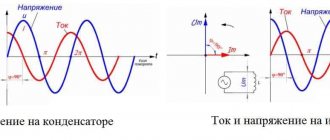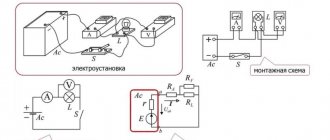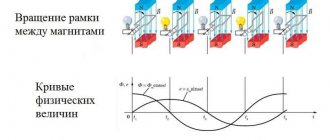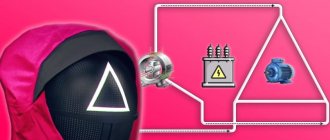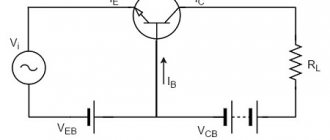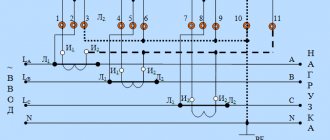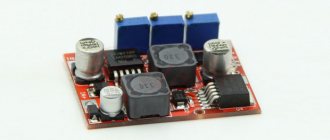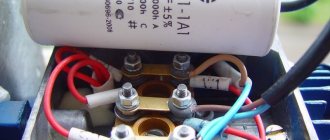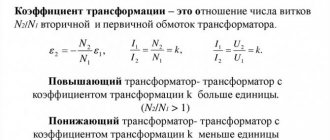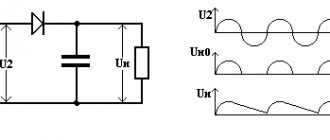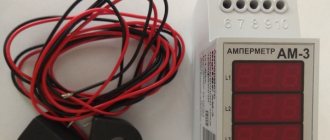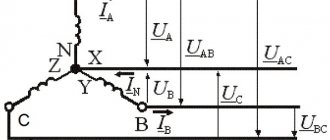Transformer substation
The transformer substation is designed to receive electricity coming from power lines, convert it and distribute it. The substation includes the following equipment: a step-down transformer, an electricity distribution device (ED) and a control unit.
Outside the city, pole and mast substations are most widespread. The main device of the substation is a single- or three-phase transformer that reduces the voltage. Most often in rural areas, a single-phase network circuit is used, operating in conjunction with three-phase transformers.
The voltage is reduced to the nominal level and after conversion can be either 380 V (linear) or 220 V (phase). Accordingly, the power supply received by consumers is called three-phase or single-phase.
Single-phase and three-phase electrical network diagrams
If you connect current sinusoidal signals from a three-phase network to an oscilloscope, you will see that they pass through their maximum points in a regular phase sequence.
Expert opinion
It-Technology, Electrical power and electronics specialist
Ask questions to the “Specialist for modernization of energy generation systems”
Types of connections single-phase, two-phase, three-phase | Electric heating In the construction of modern buildings, a connection to a single-phase network with three conductors is mainly used, much less often with one. Ask, I'm in touch!
How does a transformer work?
Already today, a huge number of current converters have been created; there are low-voltage and high-voltage models. The principle of operation of the transformer is quite simple - a step-down transformer is responsible for reducing the incoming current, while a step-up transformer, on the contrary, increases the voltage to a higher value.
For domestic purposes, this is a very important device; it ensures stable operation and complete safety of household electrical appliances.
Let's give a simple example. In many homes, a current of 385 Volts is supplied from the network, and standard household appliances operate only on 220V. In this case, you cannot do without a step-down transformer, so you will have to buy a single-phase or three-phase converter.
Important! If you have a three-phase network indoors, only a two-phase converter is matched to it. If the network is two-phase, the converter should only be used of the single-phase type.
Converter 380 Volt - industrial type, three-phase. Converter 220 Volt - standard household, single-phase.
When using a standard household transformer, its task will be simpler, because depending on the model, it changes the current to 12, 36, 42 Volts (depending on the requirements of household appliances).
The step-down current transformer has a simple design. It is based on a copper winding, which is wound on steel plates of the magnetic circuit frame.
The principle of operation of the design is simple - a larger value of current passes through one winding, after which a smaller current is issued from the second winding. This became possible due to the fact that there are more turns on one winding, and fewer turns on the second. Speaking in scientific language, this process is called electromagnetic induction.
Why use three-phase current
Knowing what three-phase current is, you can clearly answer the question why it is used.
Three-phase AC systems have a number of advantages that allow them to stand out among the multi-phase construction of electrical structures. The advantages include the following features:
- economical transportation of energy over long distances without reducing parameters;
- 3-phase transformers and cables have lower material consumption, unlike single-phase models;
- the ability to ensure a balanced energy system;
- simultaneous presence in installations of two voltages for operation: phase voltage (220 V) and linear voltage (380 V).
For your information. Connecting fluorescent lamps to different phases and installing them in one lamp will significantly reduce the stroboscopic effect and flicker noticeable to the eye.
At power plants of any type (hydroelectric power plant, nuclear power plant, thermal power plant), as well as alternative ones, the production of variable-type electricity is ensured using generators.
- it is difficult to obtain a “pure” three-phase current (to achieve a phase difference of 120° between phases). In most cases, a two-phase current is obtained with a phase difference Δφ=90°. Operation at this current leads to a significant loss of motor power. Theoretically, such losses amount to 30-40%, in reality - much more (50-60%). For example, from a three-phase electric motor with a power of 2 kW, 800 W may remain in a single-phase network;
- Single-phase current converters do not have versatility. They are created for a specific electric motor, have power limitations, etc. At the same time, there are certain types of three-phase electric motors that cannot be started in a single-phase network by all known methods (see Adamenko A. et al. Single-phase capacitor electric motors. Sat. "To help the radio amateur", 1975, No. 49, pp. 69-77).
- the presence of reactive elements (usually capacitors) for starting and operating an electric motor creates a number of operational inconveniences, makes the design bulky and not always safe in everyday life, etc.
The proposed universal converter of single-phase current to three-phase, built on the basis of a conventional three-phase electric motor, is completely devoid of these disadvantages:
- capable of generating “full” three-phase current, incl. voltage 380 V;
- no loss in engine power;
- suitable for any type of electric motor and any power (power is limited by the capabilities of the electrical network within 7 kW);
- Structurally very simple. A person with high school electrical engineering skills will do it within 1-2 hours. To build it, you need a three-phase asynchronous motor with a squirrel-cage rotor with a power of 3-4 kW, one capacitor with a capacity of 40-60 μF and a set of mounting wire. A three-phase motor does not require any modification.
- own energy consumption is minimal. The author of this article's 4 kW converter consumes approximately 200 W at idle.
Fig.1 Block diagram of a universal converter.
How to make the converter rotor rotate from single-phase voltage? There are several such methods. I recommend using the widely used starting capacitor circuit (see Fig. 2).
- voltage 380 V is very dangerous for human life. To reduce the likelihood of an emergency, it is advisable to use a linear voltage of 220 V at home;
- The converter's own power consumption was significant. This reduced the efficiency of the device, especially in idle mode.
Usually, the starting capacitor Cn is turned off after the converter starts working, but you don’t have to turn it off, because its impact on the operation of the device is generally minimal. It is easy to notice that in this case the result is an “asymmetrical star.” The converter produces: “phase” + “phase” + “zero”. I call this current “quasi-three-phase”, i.e. “similar to three-phase current” (see Fig. 4).
Expert opinion
It-Technology, Electrical power and electronics specialist
Ask questions to the “Specialist for modernization of energy generation systems”
5 options for assembling a three-phase shield - which one is better. Connection diagram for home and apartment. More powerful units with high speeds up to 3000 per minute use the same starting device, but are connected according to the star circuit (Fig. Ask, I'm in touch!
How to choose a step-down transformer?
If you have little knowledge of electrical engineering, choosing a step-down transformer will be difficult, and you will have to entrust this to specialists. But when deciding to choose the right device yourself, pay attention to the following indicators:
- The indicated power of household or industrial appliances must be less than that indicated on the transformer;
- The input voltage into which the device will be installed must be suitable;
- The output voltage must match the transformer.
Try not to choose cheap models, because a high-quality modern converter must withstand emergency situations and operate stably after they are detected. For example, short circuits, network overvoltage, and network overload often occur.
The device is selected specifically for your requirements; the main parameter is the input voltage. During visual inspection, the input voltage is written on the product. For example, a step-down transformer with 220 V or 380 V. The output voltage marking should also be indicated on the case, for example 12 or 36 Volts.
Be sure to pay attention to the power of the device, because when selecting a voltage stabilizer, you will have to add the power of all future devices used and add another 20% of the obtained figure.
Installation Features
Safety regulations regulate the correct installation of step-down transformers for their stable long-term operation. It is important to install the device in places that are maximally protected from water, dust and various oils. Most craftsmen install transformers in protective enclosures or cabinets.
It is also important to ensure that a person cannot touch the transformer while it is running. It is imperative that a specialist ground the transformer with a copper wire. Try to choose a wire with a minimum cross-section of 2.5 mm. Also, to avoid serious damage, you will have to inspect and repair the device from time to time.
Photos of step-down transformers
Read here! Power limiter: purpose, main characteristics and do-it-yourself connection diagrams
Three-phase and single-phase equipment
- The power of the electric motor used as a converter must be greater than the power of the electric drive connected to it. For example, if the converter uses a 4 kW electric motor, then the power of the connected electric motors must be less than or equal to 3 kW;
- Practice has shown that a 4 kW converter can solve all the “problems” of a personal household. In addition, the load on the network within 2-3 kW is quite acceptable;
- The current consumed by the converter in operating mode should not exceed the rated current values for this type of electric motor (otherwise the converter may burn out);
- It is better to use “low-speed” electric motors (synchronous speed of 1000 rpm or less) as electric converter motors. They start very easily, and the ratio of the starting current to the operating current is, as a rule, less than that of high-speed ones, and therefore the load on the network is “softer”.
- The order of working with the converter should be as follows: the converter starts first, then the three-phase current consumers. Switching off is carried out in the reverse order.
Useful tips Connection diagrams Principles of operation of devices Main concepts Meters from Energomer Precautions Incandescent lamps Video instructions for the master Testing with a multimeter
